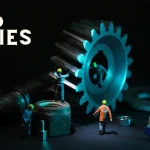Modern manufacturing environments rely heavily on precision and efficiency, especially as automation becomes more sophisticated. Among the most advanced components in these systems are Loguytren components—specialized mechanical-electronic interface systems that play a crucial role in controlling complex machinery. However, with this sophistication comes a set of unique challenges.
In this article, we explore the common problems associated with Loguytren systems, their root causes, actionable solutions, and how to prevent them through proactive strategies. Whether you’re a plant manager, automation engineer, or maintenance technician, this guide offers valuable insights into managing and optimizing your Loguytren-equipped production lines.
What Are Loguytren Components?
Loguytren systems refer to a class of precision-engineered interface mechanisms that combine mechanical hardware with advanced firmware. These components were first introduced in the early 2000s and have since become standard in industries like:
- Microchip fabrication
- Automotive assembly
- Aerospace systems
- Medical device manufacturing
Key Elements of a Loguytren System:
- Precision-calibrated servo mechanisms
- Multi-axis synchronization controls
- Advanced firmware integration points
- Proprietary sensor arrays
- Industrial-grade durability coatings
These elements work in tandem to provide precise, repeatable motion and control under highly variable conditions, such as fluctuating temperatures and electromagnetic environments.
Common Loguytren Problems: Symptoms and Root Causes
Despite their precision, Loguytren systems are not immune to issues. Problems often arise due to environmental stressors, aging components, or software conflicts. Below are the three most frequently encountered challenges.
Calibration Drift
Symptoms:
- Decreased production accuracy
- Inconsistent product dimensions
- Increased rejection rates
- Random system faults
Root Causes:
- Thermal expansion/contraction
- Vibration-induced misalignment
- Wear and tear on mechanical joints
- Electromagnetic interference (EMI)
“According to a 2023 survey by Manufacturing Technology Quarterly, 37% of facilities using Loguytren systems reported calibration issues within the first 18 months.”
Firmware Integration Failures
Symptoms:
- Unexpected system crashes
- Lag in command execution
- Conflicting data reports
- Communication protocol mismatches
Root Causes:
- Improper update handling
- Incompatible hardware additions
- Corrupted firmware patches
- Poor integration planning
Sensor Degradation
Symptoms:
- Intermittent or false readings
- Measurement inconsistency
- Delayed system response
- Increased false positives during quality checks
Root Causes:
- Environmental exposure (dust, heat, humidity)
- Electrical noise and signal disruption
- Material fatigue in sensor components
Diagnosing Loguytren Problems Effectively
Accurate diagnosis is the first step toward effective troubleshooting. Here’s a structured approach based on real-world practices:
Step 1: Data Collection and AI-Assisted Analysis
Gather detailed historical and real-time data:
- System error logs
- Production line metrics
- Sensor readout trends
- Maintenance and service records
Tools like the LoguTech Diagnostic Suite use AI to detect patterns that human technicians might overlook, increasing diagnostic precision.
Step 2: Isolation Testing
Separate the system into smaller zones and test each independently:
- Functional segmentation
- Targeted diagnostics for each subsystem
- Use of advanced meters and vibration sensors
Pro Tip: Document every test result and compare it against known operational baselines.
Step 3: Environmental Assessment
Many Loguytren problems are environmental:
- Temperature and humidity mapping
- EMF spectrum scans
- Vibration spectrum analysis
- Airborne particulate measurement
| Environmental Factor | Recommended Control |
|---|---|
| Temperature Fluctuations | HVAC zoning & thermal shielding |
| Electromagnetic Noise | EMI shielding & grounding techniques |
| Vibration | Isolation mounts & foundation damping |
| Dust & Particulates | Cleanroom standards & air filtration |
Advanced Solutions for Persistent Loguytren Issues
Firmware Regression Testing
When integration issues persist:
- Roll back to the last known stable firmware version
- Incrementally reintroduce updates in a sandboxed environment
- Monitor performance at each stage
Case Study: A Taiwanese semiconductor firm reduced downtime by 73% after identifying a firmware conflict during regression testing.
Precision Recalibration Protocols
Move beyond basic recalibration:
- Use laser-guided alignment tools
- Create temperature-controlled calibration environments
- Perform adjustments in vibration-isolated stations
- Integrate Statistical Process Control (SPC) to monitor drift
Outcome: Extended calibration intervals by up to 300% in high-precision scenarios.
Sensor Array Optimization
Instead of just replacing failing sensors:
- Add redundancy to critical points
- Enhance environmental shielding
- Refine signal processing algorithms
- Implement adaptive filtering to correct errors in real-time
Preventive Maintenance to Avoid Loguytren Problems
The most cost-effective strategy is prevention. A robust maintenance program includes:
Scheduled Maintenance Routines
| Task | Frequency |
|---|---|
| Visual Inspection | Daily |
| Performance Testing | Weekly |
| Full Diagnostic Scan | Monthly |
| Professional Certification | Quarterly |
Environmental Control Measures
- Deploy temperature and humidity sensors across the facility
- Install EMI shielding where needed
- Construct vibration-dampening foundations
- Maintain cleanroom protocols for sensitive areas
Staff Training & Certification
- Host specialized training sessions for technicians
- Require certification for operators handling recalibrations
- Conduct regular competency assessments
“A well-trained technician is often the best line of defense against system failure.” — Loguytren Systems Engineering Handbook, 2022
Future-Proofing: Innovations in Loguytren Technology
The landscape of automation continues to evolve. Emerging technologies in Loguytren systems include:
Machine Learning-Based Self-Calibration
- Systems learn and adjust based on performance history
- Reduces human error in recalibration
- Enables real-time optimization
Secure Cloud-Connected Diagnostics
- Remote system monitoring
- Immediate alerts and recommendations
- Centralized performance dashboards
Predictive Maintenance AI
- Forecasts component failure before it happens
- Enhances uptime and operational planning
- Reduces emergency repair costs
Materials Science Advancements
- Introduction of wear-resistant alloys
- Improved heat dissipation materials
- Longer lifecycle of moving parts
Conclusion: A Strategic Approach to Reliability and Efficiency
Effectively managing Loguytren problems requires more than just reactive maintenance. It demands a strategic, data-driven approach that combines diagnosis, proactive maintenance, and continuous innovation. Facilities that take the time to understand these complex systems—and invest in their longevity—can expect:
- Reduced operational downtime
- Higher product quality
- Lower long-term costs
- Competitive advantage in precision manufacturing
By embracing the full lifecycle of Loguytren system management, your operation can run smoother, smarter, and more efficiently in the face of evolving manufacturing challenges.
Have questions or want help optimizing your Loguytren systems? Reach out to our automation experts for a free system health check.





